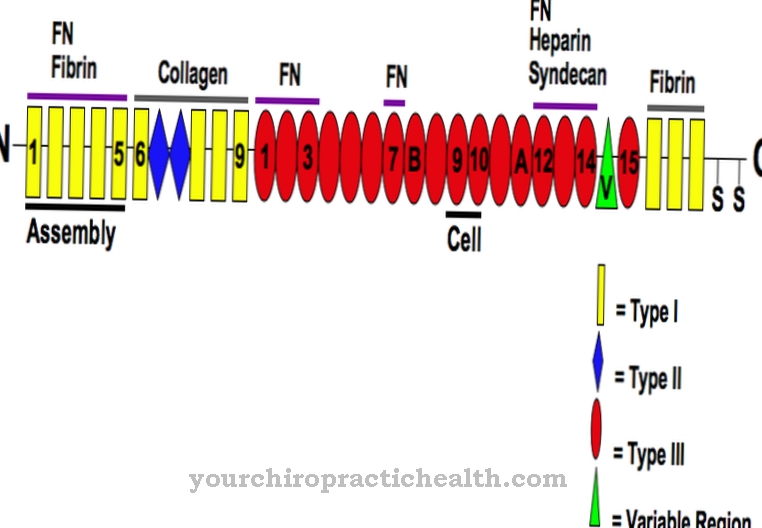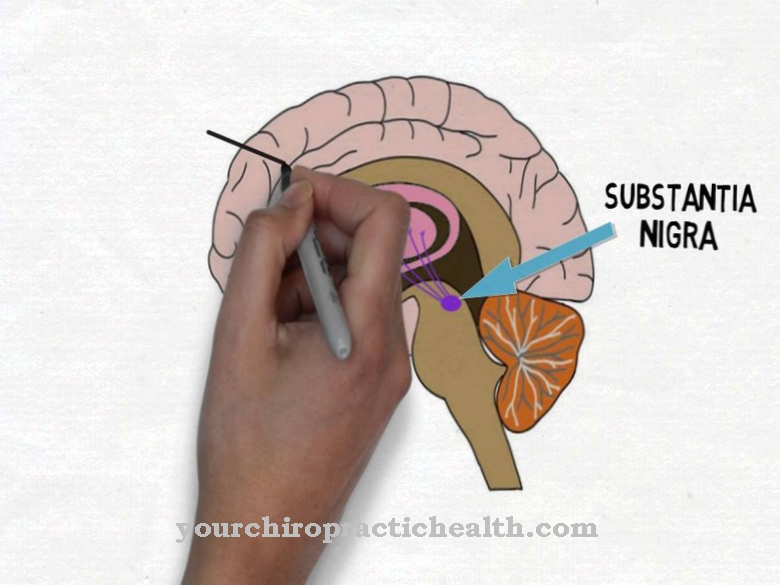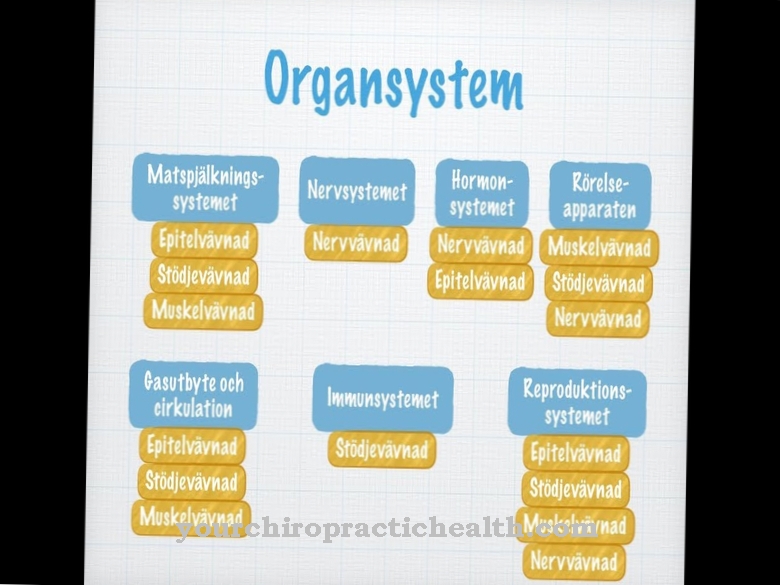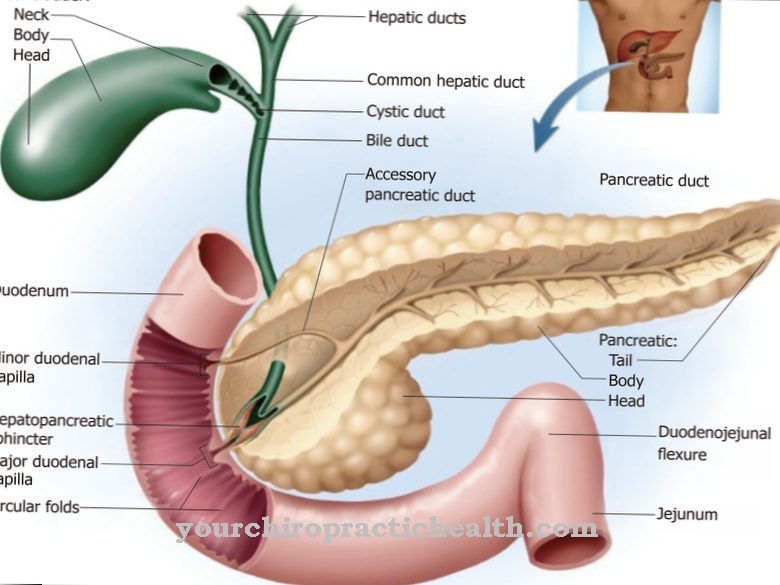The Ansa cervicalis (profunda) or Neck nerve loop lies under the sternocleidomastoid muscle and contains fibers from the cervical spinal cord segments C1 to C3. It is responsible for controlling the lower hyoid muscles (infrahyoid muscles) and can lead to swallowing disorders in the event of a lesion.
What is the ansa cervicalis?
The ansa cervicalis is a loop of nerves that lies under the sternocleidomastoid muscle in the neck. Without an addition, medicine usually means the ansa cervicalis profunda, which is the original name of the loop.
The anatomy used to distinguish between the superficial cervical nerve loop (Ansa cervicalis superficialis) and the deep cervical nerve loop (Ansa cervicalis profunda). The ansa cervicalis superficialis represents a connection between two nerves: It is not located below, but on the sternocleidomastoid muscle and connects the transversus colli nerve with the facial nerve branch. The latter represents a branch of the facial nerve (nervus facialis). This corresponds to the seventh cranial nerve. The term Ansa cervicalis superficialis no longer occurs in the new nomenclature. Less often, the anatomy also calls the ansa cervicalis ansa hypoglossi, as it runs in the carotid triangle (Trigonum caroticum) next to the nervus hypoglossus.
Anatomy & structure
Based on their fibers, two roots of the ansa cervicalis can be distinguished anatomically: the radix inferior and the radix superior. The nerves that belong to the inferior radix have their origin in the cervical spinal cord segments C2 and C3.
In contrast, the superior radix consists of fibers that are assigned to the spinal cord segments C1 and C2. Both roots of the ansa cervicalis contain nerve cords that originate from the cervical plexus and contain both motor and sensory fibers. The cervical plexus is a plexus of nerves in the human neck and comprises not only axons from segments C1 to C3, but also from C4 and (to a lesser extent) C5.
The ansa cervicalis is located under the sternocleidomastoid muscle, which participates in certain head movements and supports breathing as an auxiliary muscle. In its course in the neck, the ansa cervicalis first passes the internal jugular vein and then the anterior scalene muscle before it reaches the carotid triangle (trigonum caroticum). There it meets the sublingual nerve (nervus hypoglossus or 12th cranial nerve), to which the ansa cervicalis has no anatomical or functional connection.
Function & tasks
Nerve fibers from the ansa cervicalis control the movements of the lower hyoid muscles. This is also known as the infrahyoid muscle and consists of the omohyoideus muscle, the sternohyoideus muscle, the sternothyroideus muscle and the thyrohyoideus muscle. As a group, the lower hyoid muscles work together with other muscles (for example the upper hyoid muscles or suprahyoid muscles) in the swallowing process, which requires precise coordination of movements.
The complex interplay of muscles is possible in healthy people thanks to the swallowing centers in the brain stem and cerebrum and the interconnection of the innervating peripheral nerves.
These motor nerve fibers are efferent pathways that descend from the brain through the spinal cord and finally reach the peripheral nervous system via the spinal nerves. The neural signal changes from one nerve cell to the next by crossing biochemical synapses. At such a switching point, nerves can process information that arrives at their membrane. Activating (excitatory) and inhibiting (inhibiting) action potentials are included in this calculation according to the summation principle, which also takes into account their respective strengths. On muscle cells, the motor end plate forms the connection to the supplying nerve.
The common innervation of the infrahyoid muscles by the ansa cervicalis helps to coordinate their movements during the swallowing process: muscles that contract at the same time can receive the electrical signals from the same nerve pathway, which only divides into individual fibers at a later point in time and onto them Way it appeals to different muscle cells. In addition, the interaction helps to automatically inhibit certain muscles while others are active. Such an inhibition prevents the muscles from interfering with one another.
You can find your medication here
➔ Medicines for paresthesia and circulatory disordersDiseases
Damage to the ansa cervicalis can impair the function of the infrahyoid muscles and lead to swallowing disorders (dysphagia).
Masses of tumors, injuries and tissue infections can directly damage the ansa cervicalis. Since its nerve fibers originate from the cervical plexus, a lesion of the plexus also affects the ansa cervicalis. Radiation therapy for the treatment of breast cancer can in some cases damage the cervical plexus and cause the failure of nerve fibers that also cross the ansa cervicalis.
Missing or incorrect information transmission in the neck nerve loop can, however, also be due to neuromuscular diseases such as myasthenia gravis. In this disease, blocked acetylcholine receptors impair signal transmission at the motor endplate. Myasthenia gravis typically affects the muscles of the eye first, before the muscles that hold the head and facial muscles also suffer from paralysis. The neuromuscular disorder can spread to other muscles including the respiratory muscles. Possible neuromuscular causes of swallowing disorders also include Guillain-Barré syndrome (which is caused by inflammation of the nerves) and myotonic dystonia (which leads to tone disorders).
Even further up in the hierarchy of information processing, diseases of the brain can result in the ansa cervicalis receiving insufficient nerve signals and developing dysphagia. Neurodegenerative diseases such as Alzheimer's, Parkinson's, ALS and Huntington's chorea come into consideration as well as tumors, strokes and bleeding in the brain.

























.jpg)

.jpg)
